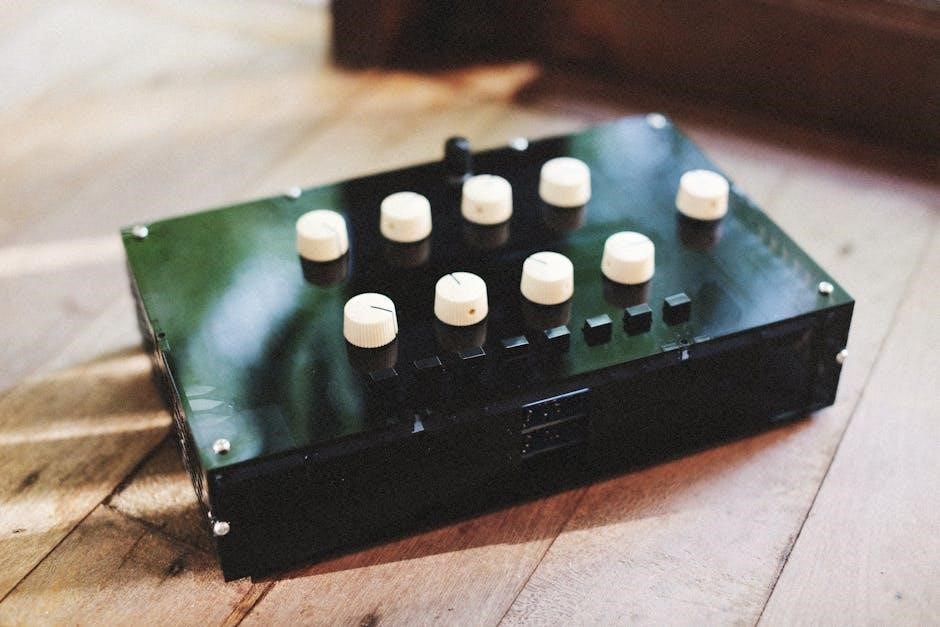
manual boost controller diagram
A manual boost controller is a device that allows drivers to adjust turbocharger boost pressure manually‚ enhancing engine performance and power output. It simplifies boost management‚ offering precise control over pressure levels‚ which is essential for optimizing turbocharged engine efficiency. By enabling manual adjustments‚ it provides flexibility for drivers to tailor boost settings to their driving preferences or conditions‚ making it a popular modification among car enthusiasts. This section introduces the basics of manual boost controllers‚ their functionality‚ and their role in enhancing turbocharged engine performance.
1.1 What is a Manual Boost Controller?
A manual boost controller is a mechanical device that allows drivers to manually regulate the boost pressure in a turbocharged engine. Unlike electronic boost controllers‚ it operates without relying on sensors or complex electronics‚ offering a simple and cost-effective way to manage boost levels. The device is typically installed between the turbocharger and the wastegate‚ enabling precise control over the pressure delivered to the engine. This makes it a popular choice for enthusiasts seeking to optimize engine performance without the need for advanced technology.
1;2 Importance of a Manual Boost Controller in Turbocharged Engines
A manual boost controller is essential for optimizing performance in turbocharged engines. It allows precise control over boost pressure‚ preventing over-boosting‚ which can damage engine components. By manually adjusting the pressure‚ drivers can fine-tune power delivery for specific driving conditions‚ enhancing responsiveness and efficiency. This control also enables better fuel economy and reduces wear on the turbocharger and engine. For enthusiasts seeking to maximize their engine’s potential without relying on electronic systems‚ a manual boost controller offers a straightforward and reliable solution to achieve consistent and predictable performance.
How a Manual Boost Controller Works
A manual boost controller regulates boost pressure by controlling the wastegate’s operation. It adjusts the pressure signal‚ allowing more or less boost to reach the engine‚ optimizing performance.
2.1 Basic Principles of Boost Pressure Regulation
Boost pressure regulation in a manual boost controller relies on controlling the wastegate actuator. The controller adjusts the pressure signal sent to the wastegate‚ determining when it opens or closes. By altering this signal‚ the controller regulates the amount of exhaust gases redirected away from the turbocharger. This balance ensures optimal boost levels‚ preventing over-boosting and maintaining engine stability. The system operates based on vacuum and pressure principles‚ using hoses and valves to manage airflow and pressure distribution within the turbocharger system.
2.2 Role of the Wastegate in Boost Control
The wastegate is a critical component in boost control‚ responsible for regulating exhaust gas flow to the turbocharger. It operates by opening or closing to vent excess gases‚ preventing over-boosting. Connected to the turbocharger‚ the wastegate receives pressure signals from the boost controller‚ ensuring optimal boost levels. When pressure exceeds the set point‚ the wastegate opens‚ diverting gases away from the turbine. This balance prevents engine damage while maintaining performance. The wastegate’s precise operation is essential for stable boost pressure‚ making it a key element in effective turbocharger management.

Components of a Manual Boost Controller
The manual boost controller consists of a boost dial‚ vacuum hoses‚ and a wastegate actuator. These components work together to regulate boost pressure effectively‚ as shown in the diagram.
3.1 Key Parts of the Manual Boost Controller
The manual boost controller includes essential components like the boost dial‚ vacuum hoses‚ and wastegate actuator. The boost dial allows precise adjustment of boost pressure‚ while the vacuum hoses connect to the turbocharger and wastegate. The wastegate actuator regulates pressure‚ ensuring proper turbo operation. A 3-way tee may also be included for vacuum line routing. These parts work together to provide manual control over boost levels‚ as illustrated in the diagram‚ ensuring optimal engine performance and responsiveness. Understanding these components is crucial for effective installation and operation.
3.2 Understanding the Diagram Symbols
The manual boost controller diagram uses specific symbols to represent key components and their connections. The boost dial is often depicted as a circular or oval shape with adjustment markings. Vacuum hoses are shown as lines connecting the controller to the turbocharger and wastegate. The wastegate actuator is typically illustrated as a small cylinder with an arrow indicating direction. Flow arrows in the diagram show the path of boost pressure through the system. Understanding these symbols is essential for correctly interpreting the diagram and ensuring proper installation and adjustment of the manual boost controller.

Installation Guide for a Manual Boost Controller
Installing a manual boost controller involves connecting it to the wastegate and turbocharger. Locate the vacuum ports and connect the hoses as shown in the diagram. Ensure the arrow on the controller points toward the wastegate for proper flow. Secure the boost dial and verify all connections are tight. This setup allows manual adjustment of boost pressure‚ enhancing engine performance and control.
4.1 Step-by-Step Installation Process
Allow the engine to cool before starting the installation. Locate the wastegate and turbocharger ports. Connect the manual boost controller (MBC) to the wastegate actuator‚ ensuring proper alignment. Use the provided T-piece to link the MBC to the turbocharger’s vacuum line. Secure all connections tightly to prevent leaks. Mount the MBC in an accessible location‚ such as under the hood or dashboard. Adjust the boost dial to your desired setting‚ then test the system by monitoring boost pressure with a gauge. Ensure all hoses are correctly routed and the arrow on the MBC points toward the wastegate for proper function.
4.2 Common Mistakes to Avoid
When installing a manual boost controller‚ avoid common errors that could lead to improper function or engine damage. Ensure the MBC is correctly oriented‚ with the arrow pointing toward the wastegate. Improper routing of hoses or misconnecting the T-piece can cause boost leaks or inaccurate pressure regulation. Neglecting to install a boost gauge risks over-boosting‚ which can harm the engine. Additionally‚ failing to secure connections tightly may result in vacuum leaks. Always follow the manufacturer’s guidelines and double-check all connections before testing the system. Proper installation is crucial for safe and effective boost control.

Adjusting the Boost Pressure
Adjusting the boost dial clockwise increases pressure‚ while counter-clockwise decreases it. Always install a boost gauge before making adjustments to monitor pressure accurately and safely.
5.1 How to Set the Boost Dial
To set the boost dial‚ start by ensuring the engine is at operating temperature. Locate the dial on the manual boost controller and turn it clockwise to increase boost pressure or counter-clockwise to decrease it. Use a boost gauge to monitor the pressure in real-time‚ ensuring it stays within the recommended range for your turbocharged engine. Small adjustments are recommended‚ as over-boosting can damage the engine. Always refer to the manufacturer’s guidelines for specific instructions tailored to your vehicle’s setup and performance goals.
5.2 Interpreting Boost Gauge Readings
A boost gauge measures the pressure generated by the turbocharger‚ displayed in pounds per square inch (psi) or bar. Normal readings typically range between 6-15 psi for most turbocharged engines. The gauge helps monitor whether the boost pressure is within the desired range‚ ensuring optimal performance and preventing over-boosting. If the needle exceeds the recommended maximum‚ it may indicate a malfunction or overly aggressive boost settings. Always refer to your vehicle’s specifications to interpret readings accurately and adjust the manual boost controller accordingly for safe and efficient engine operation.
Safety Considerations
Always monitor engine performance and avoid over-boosting‚ as excessive pressure can damage turbochargers and engines. Regularly inspect boost controller connections and ensure proper installation to prevent system failures.
6.1 Monitoring Engine Performance
Monitoring engine performance is crucial when using a manual boost controller. Keep track of boost pressure using a gauge to ensure it stays within safe limits. Over-boosting can damage the turbocharger and engine components. Regularly inspect the controller’s connections and hoses for leaks or damage. Listen for unusual sounds‚ such as hissing or surging‚ which may indicate improper function. Always refer to the manufacturer’s guidelines for recommended boost levels. If performance issues arise‚ like decreased power or uneven throttle response‚ adjust the controller or consult a professional to avoid potential engine damage.
6.2 Avoiding Over-Boosting
Over-boosting occurs when the turbocharger exceeds the engine’s designed boost pressure‚ potentially causing damage. To avoid this‚ always monitor boost levels using a gauge and adhere to manufacturer guidelines. Start with lower boost settings and gradually increase‚ observing engine behavior. Ensure the wastegate functions correctly and inspect hoses for leaks or blockages. Regularly check the breather hole on the boost controller for obstructions. If boost levels surge or exceed safe limits‚ reduce settings immediately. Consulting a professional for optimal tuning can prevent over-boosting and ensure reliable engine performance. Never exceed the turbocharger’s maximum rated boost pressure to avoid costly repairs.

Benefits of a Manual Boost Controller
A manual boost controller enhances engine performance by allowing precise control over boost pressure‚ optimizing power delivery. It offers cost-effectiveness compared to electronic systems and improves turbo responsiveness.
7.1 Improved Engine Performance
Installing a manual boost controller significantly enhances engine performance by allowing precise control over boost pressure. This precision enables optimal power delivery‚ reducing turbo lag and increasing torque output across the RPM range. Drivers can tune boost levels to match driving conditions‚ whether on the track or daily commuting. The ability to manually adjust boost pressure ensures the engine operates within safe limits while maximizing efficiency. This results in a smoother‚ more responsive driving experience and improved overall vehicle performance.
7.2 Cost-Effectiveness
A manual boost controller is a cost-effective solution for enhancing engine performance without the need for expensive electronic upgrades. By allowing drivers to manually adjust boost pressure‚ it eliminates the reliance on complex and costly factory systems. This simplicity reduces overall expenses while still delivering significant improvements in power output. Additionally‚ the ability to fine-tune boost levels prevents unnecessary strain on the engine‚ potentially saving money on repairs. Overall‚ a manual boost controller offers a budget-friendly way to optimize turbocharged engine performance without breaking the bank.
A manual boost controller is a straightforward‚ cost-effective upgrade that enhances turbocharged engine performance by allowing precise control over boost pressure‚ ensuring optimal power delivery and efficiency.
8.1 Summary of Key Points
A manual boost controller enables precise regulation of turbocharger boost pressure‚ enhancing engine performance and efficiency. Key components include the boost dial and wastegate actuator. Installation involves connecting the controller to the wastegate and turbocharger‚ ensuring proper airflow direction. Adjustments are made by turning the boost dial‚ with clockwise increasing pressure and counterclockwise decreasing it. Monitoring engine performance and avoiding over-boosting are critical for safety. Proper setup and regular maintenance ensure optimal functionality. This device is a valuable upgrade for drivers seeking enhanced control over their turbocharged engine’s power delivery and efficiency.
8.2 Final Thoughts on Manual Boost Controllers
A manual boost controller is a straightforward yet effective tool for enhancing turbocharged engine performance. Its simplicity and ease of installation make it a popular choice for enthusiasts seeking improved power delivery. By allowing precise control over boost pressure‚ it enables drivers to optimize their engine’s performance for various driving conditions. Proper installation and tuning are essential to avoid over-boosting and ensure reliability. Overall‚ a manual boost controller offers a cost-effective and user-friendly solution for those looking to maximize their turbocharged engine’s potential while maintaining safety and efficiency.